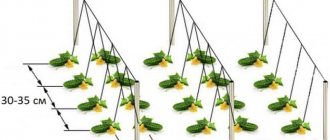Summer residents rarely plant garden crops, in particular tomatoes. But this must be done so that the bush does not bend under the weight of the fruit, and it is easier to care for it. Which garter methods are more suitable for greenhouses and open ground?
Plant staking is an essential element in growing many garden crops, especially tomatoes and cucumbers. Tomatoes are one of the most demanding crops not only in terms of care, but also in preserving the harvest, so they are the ones that most need timely garter. However, even in such a simple matter there are many nuances, without knowledge of which it is impossible to create favorable growing conditions for tomatoes.
Why tie up tomatoes?
Almost all tomatoes need tying, since tall and high-yielding varieties are often grown in greenhouses and open ground, and they definitely need to be tied. Gartering tomatoes in a greenhouse is a mandatory agrotechnical measure, and now you will find out why.
- Tall plants are not able to support the weight of tomatoes and may break.
- When gartering, the fruits are above ground level, which protects them from diseases and pest attacks.
- Tied tomatoes are easier to plant. Ovaries and fruits also form on the stepsons, but they rarely have time to ripen, but they take a lot of energy from the plant. Therefore they are usually removed.
- Tethered plants are easier to water and fertilize at the root.
Tying: why is it necessary?
So, let's try to figure out how to tie tomatoes in a greenhouse. Tying tomatoes is a simple procedure that involves attaching stems and branches to a support using ropes, strips of fabric, plastic loops and other materials. Tying is carried out immediately after pinching and formation of fruit ovaries . When the plant grows larger, the procedure will have to be repeated. Only some varieties that produce low-growing compact bushes do not require fastening.
It is necessary to tie up not only the stems of the plant, but also the branches with fruits. In some cases, it is worth securing them in two or three places. Do not tie knots tightly or pull plants too close to the support. If necessary, the fastening can be removed and the stem or branch tied in another place.
Benefits of proper garter
Proper staking of tomatoes in a greenhouse brings great benefits to the plants themselves, and also affects the result:
- Tomatoes do not tolerate moisture on their stems and leaves. Vertical plants can be watered at the root, which will help avoid rotting and disease;
- Hanging tomatoes are easier to collect, they are not affected by late blight and do not become prey for slugs;
- Heavy branches do not break even with a very large number of fruits;
- When tied, the plants receive more light and air, which speeds up the ripening of tomatoes;
- Caring for tomatoes is simplified: weeding, fertilizing, pinching, etc.
Garter tomato in a greenhouse
It is easier to fix tomatoes in a vertical position in a greenhouse than in open ground. All that is needed to tie up plants is supports and garter material (narrow strips of fabric, nylon tights or knee socks). Plastic clips are great for this task and can be used for several seasons.
For tying, do not use wire, fishing line, thread, twine or other thin and hard materials.
Tying options
There are several of the most popular options for gartering tomato bushes. The choice of mounting option depends on the variety, the height of the mature bush, the yield of the greenhouse type and other factors.
Tying to a separate support
This option is suitable for mini-greenhouses, mobile and small stationary greenhouses in which compact and medium-sized bushes are planted. As supports , you can use wooden stakes of approximately the same length, metal or plastic pipes and thick rods. They are installed next to each bush and must correspond to its height. A strip of fabric is wrapped around the stem and secured to a support.
Wire frame mounting
This method is used for small bushes with abundant fruiting. You will need a large mesh metal mesh , which is wrapped around the plant. It turns out to be a wide “pipe”, the base of which is dug into the ground. If necessary, it can be moved to another place, and the stems and fruits are tied to it at any height. The only difficulty arises during the harvesting of fruits.
Linear mount
This is a very convenient method that allows you to quickly and with minimal effort secure most bushes, especially if you have a long greenhouse with plants densely planted around the edges. The structure can be installed immediately after the construction of the greenhouse, and it consists of two metal pipes , which are installed at different ends of the shelter. A rope is pulled between them , to which the bushes are tied at the same distance from each other. Disadvantage of the method: tall and abundantly fruiting bushes cannot be secured in this way.
Gartering a tomato using a trellis
Gartering a tomato in a polycarbonate greenhouse has its own characteristics. In particular, the trellis method of gartering tall tomatoes is most often used there. A pair of strong supports are installed at different ends of the greenhouse, and ropes are pulled between them at different heights with an interval of 30 cm. Tall stems are attached to ropes with plastic clips or threaded through a rope “mesh”. This method of fastening allows you to conveniently place spreading bushes with fruit-bearing stepsons.
Vertical trellis
This design is a variation of the previous one. It is ideal for gartering tomatoes and cucumbers, especially tall ones with removed side shoots. A rope is attached to the ceiling of the greenhouse, which is secured at the base of the bush. As the plant grows, it “crawls” along it, and you only need to additionally tie it up or secure the bush with clips. With such a “rod”, even the tallest and most fruit-bearing bushes do not break.
Mesh mount
This is a combined option that combines trellis fastening and fixation with mesh. A metal or plastic mesh is stretched between the supports, which allows you to place powerful and compact bushes.
Garter material
The choice of material for a garter must be approached with all responsibility. It is important to know what and how to tie tomatoes. The garter should not cut the delicate surface of the stem and branches, accumulate moisture and rot. It should be convenient to make knots without fear that the twine or strip of fabric will tear. The garter material is prepared for one season, and after harvesting it is destroyed to exclude the possibility of transferring the infection to the next year.
It is prohibited to tie up tomato bushes:
- wire;
- thin twine;
- fishing line.
It is better to prepare strips of synthetic fabric up to 5 cm wide and quite long. This can be a nylon utility cord, ordinary twine, or nylon stockings cut into strips.
Tomato garter clips make the job much easier. They come in wood or plastic, are very inexpensive, and are sold individually and in sets. The clip wraps around the stem and snaps into place without pinching it.
When tying with improvised material - strips of fabric or soft ties, you only need ordinary scissors.
And if you have garden tapeners, there is no need for either scissors or material for gartering.
A tapener is a simple device into which adhesive tape is inserted, capturing the stem of the plant along with a peg, mesh cell, and wire. Designed to simplify and speed up gartering. It works on the principle of a stapler, but looks like a garden pruner. A soft ribbon is tucked into the device and carefully bends around the stem. It is very convenient to use, and with a trellis-type garter, when the tomatoes are tall, this is an indispensable tool.
The handles are comfortable, the hand does not get tired. In any online gardening store you can buy a tapener with a set of tapes, staples, a spare knife and a replacement screw. This tool is also useful for tying grapes, cucumbers, and other tall crops.
Tomato garter in open ground
Almost all of the methods described above are suitable for open ground; the main thing is not to use natural fabric, since it rots and over time becomes a breeding ground for pathogenic bacteria. Let's talk about the features of each method of gartering tomatoes.
1. Pegs for gartering tomatoes . In a greenhouse, plants are little affected by weather conditions. When grown in open ground, tomatoes have to deal with wind and rain, so the requirements for supports are more stringent. For seedlings of low-growing and medium-growing tomatoes, the stakes should be 25-30 cm higher than the bushes, and tall varieties need supports 2-2.5 m high. Each peg is buried to a depth of 20-25 cm, and it should be 10-10 cm away from the trunk. 15 cm so as not to damage the root system. Do not tighten the garter material tightly so that it does not squeeze the stem.
2. “Tomato cages” - for each bush or group you can build a small separate structure in which the plants will be protected and securely fastened.
3. Caps . Unusual and convenient designs, suitable exclusively for open ground and any tall plants. The essence of an improvised “wigwam” is to build a pyramid from available materials. Most often they use wire, vines or stakes with a transverse ligament. The pyramid covers several young plants at once, and the distance between the structures should be about 1 m.
4 . "On hook" . Sticks should be installed on both sides of the tomato ridge to tie up the bushes. A cable is pulled between them. A fishing line with loops at different heights is attached to it (the distance between them should be 20-25 cm). S-shaped hooks made of thick wire are inserted into the loops, which tighten the fishing line. Its other end is tied to a peg near each plant. Now all that remains is to place an elastic rubber ring under a branch or a bunch of tomatoes (it can be cut from a bicycle inner tube) and put it on the hook. As the bush grows, the hook is removed from the loop and threaded into a higher loop.
Deadlines
The main task of tying up tomatoes is to ensure normal air circulation in the garden bed, access to each bush, and so that the branches do not break. The bush cannot be allowed to overgrow in order to form an even main stem in time.
The bushes are tied to a support when they begin to bend. At this time, the stem reaches the desired thickness and height. The bush has already formed up to 10 true leaves. A strong bush is no longer a tender seedling that can be easily damaged when staking.
Tomatoes can be divided into three varietal groups - early-ripening, mid-ripening and late-ripening tomatoes. The tying time for each variety after planting seedlings in the ground or under film is as follows:
- early varieties - from 35 to 40 days;
- mid-ripening varieties - at 50-60 days;
- late varieties - at 70-80 days.
The garter period depends on the growing region, soil quality, fertilizing and other factors affecting plant growth. Over time, experience is gained and the gardener himself is able to determine a convenient time.
Unusual ways to garter tomatoes
All non-standard methods of gartering tomatoes involve using original support structures. To sell many of them, they use willow twigs, hazel, blackberry stems, cuttings of seedlings, tree and plant vines, twine or grape vines.
- Support made of hoops . To create this cage support you need three poles and three hoops of different diameters. The diameter of the hoops increases from bottom to top, and the stem is attached to them using plastic clips.
- V -shaped grille . In this case, two buried grates are used, which deviate from each other in different directions. Plants are located between them and naturally support the structure throughout the season. The height of the trellises should be selected depending on the expected height of the plant. There is no need to tie up the plants; they themselves “spread” freely along the trellis.
- Old television antenna . Some items are already ready-made supports for tomatoes and other crops. For example, such as a branched mast or an unnecessary television antenna.
What tomatoes can be grown without a garter?
Without a garter, you can grow low-growing and early-ripening varieties . It is often said that determinate varieties . These tomatoes stop growing after setting 4-5 bunches. From the general group of determinate tomatoes, superdeterminate , which ripen very early and do not require pinching at all. In “simply” determinate plants, you need to remove excess shoots, otherwise you can end up with a plant overloaded with fruits that will develop poorly.
But still, the best choice for those who want to simply plant a plant and enjoy the harvest are standard tomatoes . This is one of the varieties of determinate tomatoes, which are distinguished by a short and dense stem and small stature.
After our advice, gartering tomatoes doesn’t seem like such a scary task to you anymore, does it? Do not neglect this important agricultural technique, and your tomatoes will always look healthy and bear fruit abundantly.











